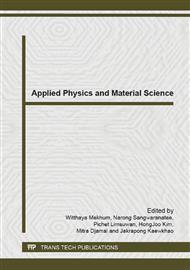p.232
p.236
p.240
p.244
p.248
p.251
p.255
p.259
p.263
Effects of Annealing Treatment on WO3 Thin Films Prepared by DC Reactive Magnetron Sputtering
Abstract:
Tungsten trioxide (WO3) thin films were prepared by a DC reactive magnetron sputtering technique. The thin film fabrication process used tungsten (99.995%) as the sputtering target, the mixture of argon and oxygen as sputtering and reactive gases, and silicon (100) and glass slides as the substrates. The effects of annealing temperature in the range of 200-400°C on physical and optical properties of the WO3 thin films were investigated. The nanostructures and morphologies of these films were characterized by grazing-incident X-ray diffraction (GIXRD) and field-emission scanning electron microscopy (FE-SEM). The optical properties were analyzed by variable-angle spectroscopic ellipsometry (VASE) and spectrophotometer. From the XRD results, the as-deposited and annealed WO3 thin films up to 300°C were all amorphous. Only the WO3 thin film annealed at 400°C exhibited a polycrystalline monoclinic phase. The FE-SEM cross-sections and surface topologies demonstrated nearly identical thin-film thickness and physical grain sizes. The SE analyses showed that the thin films were all homogeneous dense layers with additional surface roughness. With the annealing treatment, the thin film thickness was slightly decreased. The SE physical model was best optimized with the Cauchy optical model. The results showed that the refractive index at 550 nm was increased from 2.17 to 2.23 with the increased annealing temperature. The results from the spectrophotometer confirmed that the optical spectra for the WO3 thin films were decreased. This study demonstrated that, the thin film annealed at 400°C exhibited the slightly lower transparency, which corresponded to the results from the GIXRD and SE analyses.
Info:
Periodical:
Pages:
248-250
Citation:
Online since:
June 2014
Keywords:
Price:
Сopyright:
© 2014 Trans Tech Publications Ltd. All Rights Reserved
Share:
Citation:


